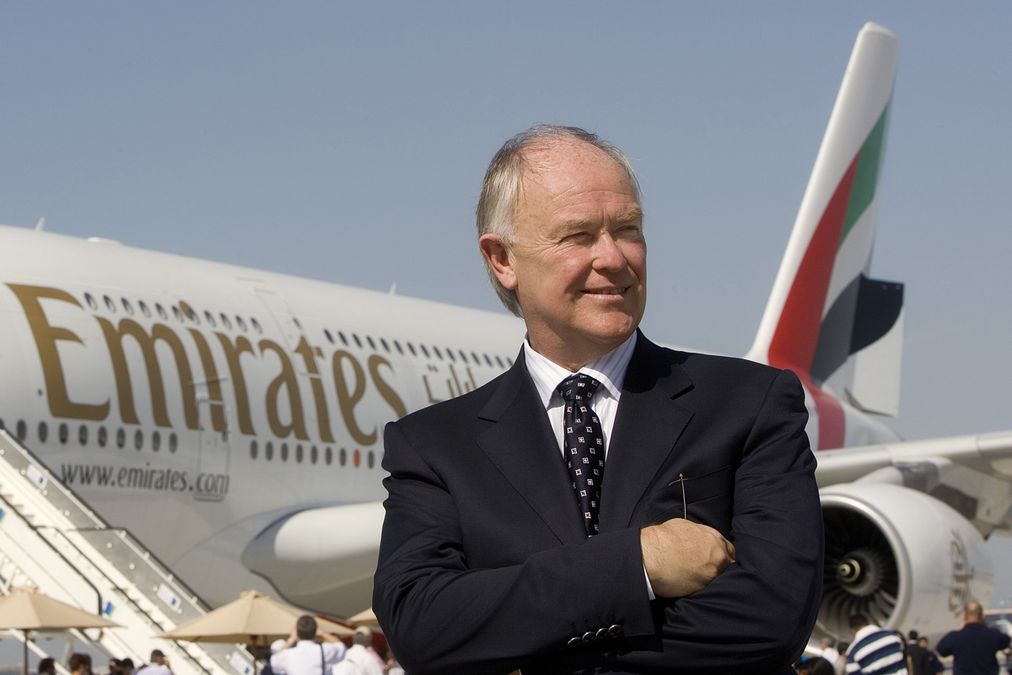Why an Emirates-Etihad merger would be the airline deal of the decade

A combination of Dubai-based Emirates and Abu Dhabi’s Etihad would be the airline industry’s deal of the decade, if it can be pulled off.
Executives at the two companies have been quietly laying plans to create what would be the world’s biggest airline by passenger traffic, according to people familiar with the discussions. The group would have combined revenue of US$29.3 billion and control almost 5 percent of the world’s airline routes.
Read more: Emirates seeks Etihad takeover to create world's largest airline
Etihad and Emirates publicly deny merger talks, but an exploratory look at Emirates taking over Etihad’s airline operations remains on the table, according to the people, who asked not to be identified discussing private considerations.
Talks have occurred on-and-off for some time, one of the people said, and any deal would face antitrust as well as political challenges.
Here are five ways a tie-up would transform the airline industry:
1. Higher fares
Passengers in Europe and Asia can expect ticket prices to rise, according to Bloomberg Intelligence analysts, as the merger partners take capacity out of the market. That would lower pressure on competitors such as Deutsche Lufthansa and Air France-KLM that fly similar routes.
Almost every route flown by Etihad is also flown by Emirates, and more than half of Emirates’ routes are duplicated by Etihad.
2. Mega-hub
A deal would inject life into the Gulf’s hub model by giving the combined group control over two major connecting airports.
“The airlines could split focus by airport to different regions, with Abu Dhabi concentrating on U.S. passengers, as it already has a U.S. pre-clearance facility that speeds passage,” according to BI analyst George Ferguson. “Dubai could focus on European travelers.”
Dubai-based Emirates used the hub concept to transform itself into the world’s largest long-haul carrier. But it’s facing pressure with the rise of competing airports in Asia and the small but fast-growing number of low-cost direct long-distance routes.
3. Planemakers get squeezed
With Emirates’ backing, Etihad would gain more clout negotiating with Airbus and Boeing to cancel part of an order book which now totals 174 planes worth US$46 billion. Emirates is a bigger and better buyer of aircraft, and a critical customer for both planemakers’ biggest jets.
Much of the potential for efficiencies in a merger would come from reducing overlap on routes, which would lessen the need for more aircraft.
“There’s a bit of complimentality but also quite a bit of overlap in those structures,” Peter Harbison, chairman of the CAPA Centre for Aviation, said in a Bloomberg Television interview. “So if you do start to rationalize you’re talking about probably removing quite a lot of aircraft from the fleet initially.”
4. Antitrust woes
One reason for caution about a tie-up is the overlap on routes. Emirates is already the dominant carrier for many destinations in the Middle East, India and Australia. That means the carriers could likely be forced to drop routes or slots at major hubs.
5. Politics
Oil-rich Abu Dhabi helped bail out Dubai after the 2008 financial crisis and remains the linchpin for the United Arab Emirates’ oil reserves.
Yet Dubai has done a better job of developing a tourism industry and has the stronger airline. While the two sheikdoms have cooperated in the past on consolidating businesses, any deal would require delicate compromises.
Then there’s the US, whose carriers have waged an ongoing protest over allegations of billions of dollars of state subsidies to Emirates and Etihad. An agreement that provides for greater transparency in financial reporting by the government-owned carriers was reached this year, but a combination of the two Gulf carriers could be seen as a bailout for struggling Etihad.
Analysis: Emirates-Etihad sibling rivalry could end badly
A takeover by Emirates of Etihad Airways is the megadeal that has to happen in the global airline industry. At the same time, it’s a poisoned chalice for the suitor that may hobble its growth plans for a generation.
The two carriers are in preliminary talks over a deal, people familiar with the matter told Bloomberg. Any discussions may be protracted because combining these two airlines will be as difficult and risky as getting hedgehogs to mate.
While countries the size of China and the US have domestic markets large enough to sustain multiple global hub carriers, the United Arab Emirates is a much smaller beast, with a population of just 9.4 million.
Trying to establish not one, but two world-connecting airlines there (just down the road from a third global hub airline in Qatar, population 2.6 million) is a bit like trying to do the same thing in Hong Kong or Singapore.
The two carriers are in many ways duplicates. Of Etihad’s 88 passenger destinations, all but 11 are also served by Emirates – and that group of destinations is a distinctly third-tier bunch including the likes of Chengdu, Edinburgh, Kathmandu, Nagoya and Riga.
Analysis of data from OAG Aviation Worldwide, an analytics consultancy, suggests that routes flown by both airlines account for about 96 percent of Etihad’s total outbound capacity this year, and 74 percent at Emirates.
The overlap is certain to be closely scrutinized by antitrust authorities, who typically view airline mergers in terms of a myriad city-pairs that each pose their own competition issues.
For many destinations in the Middle East, India and Australia, Emirates is already dominant: on routes between Australia and Europe, Africa and the Middle East, for instance, it had a 43 percent share of passenger capacity over the past year. Adding Etihad to that total is likely to be unacceptable without the carriers agreeing to drop routes or slots at major hubs.
In some places that could be a blessing. Being based in the same country, the sibling rivalry between Emirates’s base of Dubai and Etihad’s home turf in neighboring Abu Dhabi has been fierce. Any services that antitrust authorities force the parties to give up might help tighten the market and support ticket prices.
In other ways, though, it’s a minefield.
Tim Clark, Emirates’s president, has grown used to operating the company with a ruthlessly free hand, a secret to its success in recent decades. The sensible thing to do would be to effectively close Etihad down: Cherry-pick its best aircraft, employees and routes; bolt them onto Emirates’s much larger business; and dispose of the remainder. But the internecine politics of the UAE makes that impossible.
Both airlines are essentially state enterprises owned by the royal families of their respective emirates. While Dubai has always been the leader in terms of entrepreneurial zeal – one reason Emirates was established in the first place – Abu Dhabi has about 90 percent of the oil reserves that keep the whole show on the road for the UAE.
When Dubai’s debt-fueled growth path spiraled out of control during the 2008 financial crisis, it was Abu Dhabi that stepped in with $20 billion of bailout money, a sum that’s since been rolled over at below-market rates.
That means that the sensible, radical path isn’t really an option. The combined group will somehow have to maintain service levels to Abu Dhabi to please the Al Nahyan family, the final arbiter of economic and political power in the UAE, while doing its best to build up its core hub in Dubai.
It’s not clear such a model could work. The core of a hub carrier is the ease of the transfer experience and the wealth of connectivity it can offer to passengers.
That’s hard enough to manage under a single roof. Doing it with two different sites an hour apart by road seems impossible, especially as it competes with rivals connecting through sparkling new Asian airports or flying nonstop on new long-haul jets.
There are potential solutions out there. Perhaps the route network can be split such that all but a handful of low-margin passengers transit at one site or the other.
Better still, both airlines could move to the massive future Dubai World Central airport, which sits close to the border between the two emirates – though that option would leave Abu Dhabi’s Midfield terminal looking like an expensive folly before it’s even opened.
Either way, what Emirates gains in terms of scale it will lose in operational freedom. Etihad has never had a very clear reason to exist, beyond jealousy of Emirates’s success. In its current loss-making and weakened state, it may be about to deliver the most devastating blow against its sibling carrier yet.





Qantas - Qantas Frequent Flyer
23 Sep 2017
Total posts 163
I can see serious antitrust scrutiny where Australia is concerned, at least I hope so.
21 Jul 2011
Total posts 90
I bet VA is shaking in anticip.....ation.
Qantas - Qantas Frequent Flyer
29 Mar 2015
Total posts 94
Despite all the arguments above the only real reason seems to be that Emirates loses a rival and Etihad ceases to be a drain on the Emir's balance sheet.
17 Sep 2015
Total posts 388
Other media claim that political rivalries between the royal families mean this is just talk.
24 Aug 2011
Total posts 1209
A lessening of competition on European routes could see the chances of a renewal of the QF/EK JSA greatly reduced.
Virgin Australia - Velocity Rewards
11 Dec 2016
Total posts 74
Considering Ethiad's part ownership of VA. What I'm wishfully thinking out of this is for the Emirates-QF tie up to be canned and they link to VA instead.
Virgin Australia - Velocity Rewards
11 Dec 2016
Total posts 74
Or more likely is that they sell the VA shares which seems more logical but a shame.
Qantas - Qantas Frequent Flyer
01 Mar 2013
Total posts 169
Well researched. Let's not underestimate where power resides in the UAE, and it ain't in Dubai.
Hi Guest, join in the discussion on Why an Emirates-Etihad merger would be the airline deal of the decade